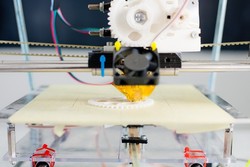3D printing: manufacturers 'should sell product designs'
Phil Taylor, 12-May-2014
 Manufacturers of branded goods should consider selling their schematics rather than trying to keep them hidden away, says a 3D printing specialist.
Manufacturers of branded goods should consider selling their schematics rather than trying to keep them hidden away, says a 3D printing specialist.
Chris Thorpe of UK company Flexiscale - which specialises in using 3D scanning and printing technologies to create model kits - believes companies need to understand and embrace 3D printing and make sure they adapt their business to accommodate a new and very different operating environment.
The bottom line? Armed with technology that is becoming increasingly common and affordable, consumers will soon be able to copy the design of just about any manufactured product on the market and produce it at home.
Google is working on a prototype cellphone, for example, that incorporates a 3D scanner, while the price of 3D printers is plummeting and some devices can be bought for as little as $350. A recent Gartner report predicted for example that 3D printing will result in the loss of at least $100bn in IP around the world by 2018.
There may however be another way for companies to look at the problem, according to Thorpe.
Services like Netflix, which allow users to pay a subscription and stream movies and television shows on demand using their TV, gaming console or PC, have had a massive impact on digital content piracy. Since Netflix hit a critical mass of users, the amount of peer-to-peer file sharing of digital content "has gone down dramatically", he told delegates at the recent IP-Protect Expo in London, UK.
Meanwhile, just about every physical product on the market now starts life as a computer-aided design (CAD) package, so why not make those designs available to consumers to purchase legally, he asked.
"Piracy does not happen because people are naturally bad," he said. "It happens because people can't buy what they want, because companies won't sell it to them." Companies should look at other ways to provide a return on their investment in design and intellectual property (IP).
There are additional benefits to this approach aside from near-term revenue generation. Customers accessing the plans will be able to print their own spare parts - doing away with the need to have massive warehouses storing pre-made components in countries like China and then shopping them around the world.
Gartner recently said that around 57,000 3D printers were sold in 2013 and it expects that figure to rise 75 per cent this year and double again to almost 200,000 units in 2015.
That is hardly mainstream technology - yet - but with companies like Staples and Asda now offering 3D print-in-store services, consumers do not even have to have their own printers to benefit from these services.
Meanwhile, Gartner expects the take-up of these devices to be driven by the availability of easier-to-deploy applications, as well as other factors such as price. By next year, it predicts seven of the 50 largest multinational retailers will sell 3D printers through their physical and online stores.
Addressing the branded product manufacturers in audience, Thorpe said: "Many of you have content that is physical, that is 3D and came from CAD."
"I urge you to sell it as digital files, as this will reduce piracy."
Image courtesy of Shutterstock
Related articles:

©
SecuringIndustry.com




 Manufacturers of branded goods should consider selling their schematics rather than trying to keep them hidden away, says a 3D printing specialist.
Manufacturers of branded goods should consider selling their schematics rather than trying to keep them hidden away, says a 3D printing specialist.